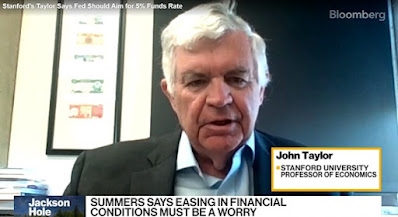Click here to read the original Cautious Optimism Facebook post with comments
The Cautious Optimism Correspondent for Economic Affairs and other Egghead Stuff is a bit surprised at Stanford economist John B. Taylor's estimate of a 5% Fed Funds rate target to bring inflation down to its 2% target.
5% is a bit lower than the Correspondent would have thought would be needed.
However the Correspondent has mucho respeto for John Taylor who incidentally was interviewed in 2017 by Donald Trump to head the Federal Reserve as a dark horse candidate.
We got Jay Powell instead.
Even Paul Krugman gives Taylor a wide berth when they disagree, which is often.
Taylor, author of the so-called "Taylor Rule" that takes wild discretion away from Fed officials and sets target interest rate ranges with a formula using objective economic indicators instead, is considered by many to be deserving of the Nobel Prize, but will likely be overlooked due to his strong Milton Friedman-influenced views and association with conservative think tanks like Stanford's Hoover Institution and the free market Mont Pelerin Society.
His argument that 5% will be sufficient is based on Robert Lucas' "rational expectations" thesis applied to inflation--that unlike the 1970's and early 1980's consumer and business behaviors have not yet been altered by an expectation that high inflation is here to stay. Such expectations, when engrained in the public psyche, would lead people to spend a greater share of their money and spend it faster, increasing monetary velocity which in turn drives inflation even higher in a cruel spiraling effect.
Which is what happened in the late 1970's after the public had eaten nearly a decade of the Arthur Burns Fed's high inflation.
So far St. Louis Fed M2 velocity data indicate inflation expectations have not taken hold in the USA (yet) but Taylor also hedged his forecast, adding that:
"It [the Fed Funds rate] could be higher. I wouldn't say absolutely 5%, it may have to be higher"
...right before saying:
"But I think inflation will come down and we can stick to a level like that."
The Correspondent would have thought higher than 5% will be needed but considers Taylor's view, optimistic as it may be, worthy of discussion.
Watch Taylor's Bloomberg interview at:
https://www.bloomberg.com/news/videos/2022-08-23/stanford-s-taylor-says-fed-should-aim-for-5-funds-rate
ps. The Fed Funds rate topped out at 5.25% in 2006 and 2007, bursting the housing bubble and precipitating the Great Recession which officially began in late 2007.
That recession was particularly awful due to government-mandated lowering of lending standards and thinner capital reserve buffers, adding a financial crisis to boot.
But that doesn't mean a "just less worse recession" isn't possible if the target rate reaches 5.25%, especially given the last two years' pace of Fed money creation which has broken all records going back to World War II.

No comments:
Post a Comment
Note: Only a member of this blog may post a comment.